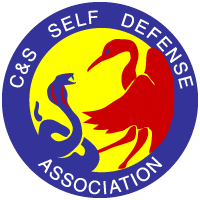
|
C&S Online
An Online Newsletter For The
C&S Self Defense Association
Spring 2003
Confidence. Fitness. Success.
|
|
Featured Articles...
|
Forearm Muscle Strike
Grandmaster Peter Rose
Rose School of Karate, Portsmouth, NH
 Here is a series
of pictures showing a possible response to a same side arm grab that is a little different than some of the situations I have examined in past articles.
Here is a series
of pictures showing a possible response to a same side arm grab that is a little different than some of the situations I have examined in past articles.
In this situation, the aggressor (Pending Black Belt Rick Downs of the Rose School of Karate, Portsmouth, NH) has grabed my wrist and pulled me toward him. This is a common occurance in grabbing attacks, particularly against women. For this reason, I want to show a series of practical movements geared for a smaller person against a larger, heavier opponent.
The first 4 pictures show a relativly straight forward response scenario that is achievable by most students with just a few months of training beyond the basic DART self defense orientation classes. The student must be familiar with the principles of body, weight, and center of mass positon, effective body strike points, and the basics of fluid shock. The remaining pictures in the series are for the more advanced student as they require a far deeper understanding of how to take advantage of the opponent's body responses to the strikes I show being used.
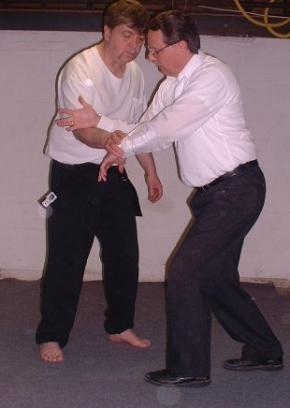 As the opponent pulls me toward him, I do a knife hand (shuto) strike to the raised part of the opponent's forearm muscle at a point just below the elbow joint. This is the only hard part of the technique: you have to hit the right spot, you have to hit it with a focused fluid shock, and you have to rake the strike downward toward you along the length of the muscle about half way down the forearm. This should cause the opponent's head to twist slightly and jerk backward exposing the side of his neck.
As the opponent pulls me toward him, I do a knife hand (shuto) strike to the raised part of the opponent's forearm muscle at a point just below the elbow joint. This is the only hard part of the technique: you have to hit the right spot, you have to hit it with a focused fluid shock, and you have to rake the strike downward toward you along the length of the muscle about half way down the forearm. This should cause the opponent's head to twist slightly and jerk backward exposing the side of his neck.
|
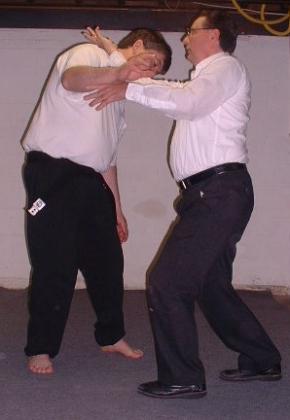 As I am doing this, I allow my body to continue moving (be pulled) toward the opponent, and deliver a slapping inverted ridge hand fluid shock strike to the opponent's brachial plexus. Even if you do not deliver this strike with full efficiently, it should still cause his body to crumple toward you - even if only slightly.
As I am doing this, I allow my body to continue moving (be pulled) toward the opponent, and deliver a slapping inverted ridge hand fluid shock strike to the opponent's brachial plexus. Even if you do not deliver this strike with full efficiently, it should still cause his body to crumple toward you - even if only slightly.
|
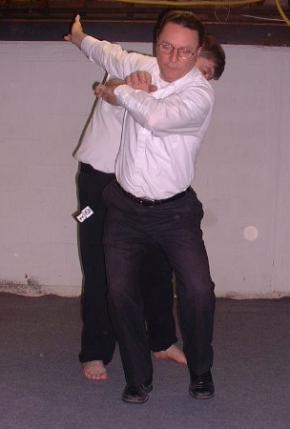 Since my body momentum is toward the opponent, I will use this against him by spinning full force into him and delivering a backward elbow strike to his lower floating ribs. Here you see me just starting this spin...
Since my body momentum is toward the opponent, I will use this against him by spinning full force into him and delivering a backward elbow strike to his lower floating ribs. Here you see me just starting this spin...
|
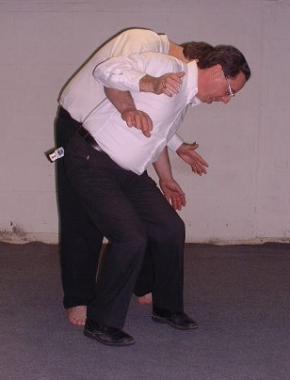 It is an easy strike, again not requiring a lot of muscle power. My body does all the work. And this is all you really have to worry about. From here, you would just step out away from the opponent and let him fall.
It is an easy strike, again not requiring a lot of muscle power. My body does all the work. And this is all you really have to worry about. From here, you would just step out away from the opponent and let him fall.
|
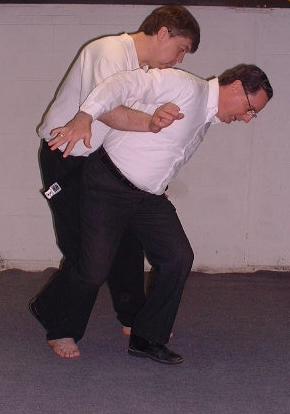 For the more experienced martial artist, you can use this body position to hook up the opponents leg. Notice that I hook up using my right leg because due to my previous spin most of my weight has transfered onto my left leg. This makes the choice of the right leg more natural. And note that the hook up is nothing fancy - in this picture all I have really done is hook his ankle up with the top part of my foot; I don't even have a full wrap on him.
For the more experienced martial artist, you can use this body position to hook up the opponents leg. Notice that I hook up using my right leg because due to my previous spin most of my weight has transfered onto my left leg. This makes the choice of the right leg more natural. And note that the hook up is nothing fancy - in this picture all I have really done is hook his ankle up with the top part of my foot; I don't even have a full wrap on him.
|
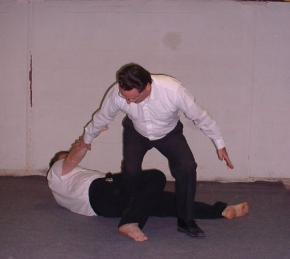 As you can see, I did not need a full wrap on the opponent's leg to take him down. When I hit him with the elbow on his left side, he will naturally try to move away from the pain and his weight distribution will shift to his right leg. The rest is just conversation...
As you can see, I did not need a full wrap on the opponent's leg to take him down. When I hit him with the elbow on his left side, he will naturally try to move away from the pain and his weight distribution will shift to his right leg. The rest is just conversation...
|
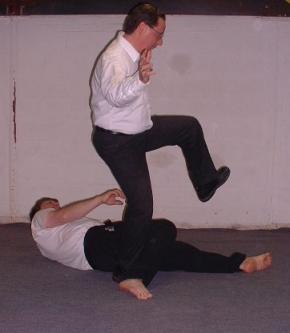 As the opponent hits the ground, rather than just turning around to pursue him I launch into an "Over-The-Fence" jump crescent kick. This will clear my legs from getting entangled in his as he falls.
As the opponent hits the ground, rather than just turning around to pursue him I launch into an "Over-The-Fence" jump crescent kick. This will clear my legs from getting entangled in his as he falls.
|
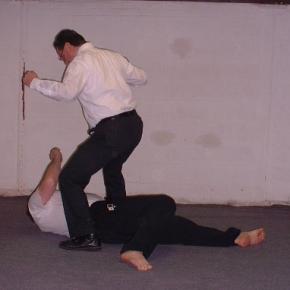 As you can see, by doing the "Over-The-Fence" I end up landing well clear of his legs and in perfect position to do a dead weight body drop strike on his floating ribs.
As you can see, by doing the "Over-The-Fence" I end up landing well clear of his legs and in perfect position to do a dead weight body drop strike on his floating ribs.
|
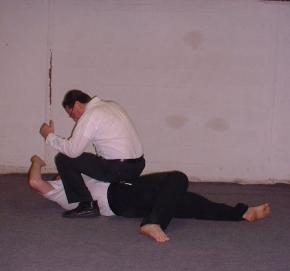 It is critical that my weight not drop on his chest - that will do no good at all. By landing where I do, I will drive the air out of him as well as crack if not break all 4 of his floating ribs. Even if my aim is off, I am better landing here than too high. And if things don't go right and I lose my balance, I can just back roll out between his legs away from him.
It is critical that my weight not drop on his chest - that will do no good at all. By landing where I do, I will drive the air out of him as well as crack if not break all 4 of his floating ribs. Even if my aim is off, I am better landing here than too high. And if things don't go right and I lose my balance, I can just back roll out between his legs away from him.
|
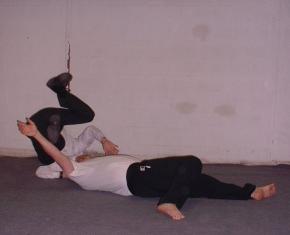 Since my landing was on balance, I choose to exit with a forward roll. This will better position me toward his head for further safe action. Whenever possible, roll out to his head rather than legs.
Since my landing was on balance, I choose to exit with a forward roll. This will better position me toward his head for further safe action. Whenever possible, roll out to his head rather than legs.
|
It is likely that some of our less experienced students may be thinking that this series - even the first 4 steps - is a little beyond them. However, I think this feeling would have more to do with the initial forearm muscle strike than anything else.
Is the strike more "complex" than a knuckle strike to the throat or forward elbow to the jaw? Well, yes probably so. But note what I said in setting the technique up: I said that the opponent had "...grabed my wrist and pulled me toward him...". Think about that for just a second. What would your normal reaction be to someone pulling you toward them? In the picture shown, am I more likely to spin my right side away from the opponent (clockwise), or am I more likely to resist the pull by pulling back against him and thus turning my whole body to the left (counter clockwise here)?
Though either reaction is possible, the more likely would be the latter where I am turning counter clockwise. The assumption here - overriding all else - is that I have been taken by surprise. I am not "thinking", I am "reacting naturally". Thus, because my attention is focused on pulling back against the opponent, I will be out of position very quickly (immediately) to throw any sort of effective strike. What is not shown in the picture series is that the opponents strong pull and my immediate pull back will cause our two bodies to collide and then briefly rebound from each other. And that is where the picture series starts; that is where the forearm muscle strike will "reveal" itself to you. It becomes the natural target of opportunity. You will see it regardless of if you are prepared for it or not. And you will react. But - as I carefully mentioned - you will need a few months of training beyond just basic self defense to be able to take advantage of the situation. But the technique itself is not a big deal.
What would be a big deal - and one which I would not even attempt - is to "plan" for this series of events so that you are "ready" with this technique series. Beware! This is not #42 of a series of 385 techniques you are going to have to memorize. This is just a situation where you will react with this technique because it will be "right" to do so. You will not have to think about it, plan for it, worry about whether you have the skill and/or ability to do it. The situation will happen. You will react. And the person will react as well.
Grandmaster Peter M. Rose holds an 8th Degree Black Belt. He began his studies with Grandmaster S.A. Brock in 1968. He has operated the Rose School of Karate in Portsmouth, NH since 1972. Grandmaster Rose is a senior software engineer, analyst, designer, and technical project manager. Grandmaster Rose can be reached at zzrose@yahoo.com, or you can visit his personal web site http://www.zzrose.com/pmr.html.
Top | Front Page | Board | Featured | Happenings | Views | Back Page | C&S Home
|
Website design by Peter Rose, zzrose@yahoo.com
|
